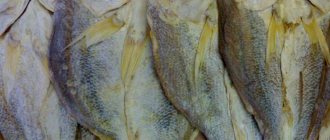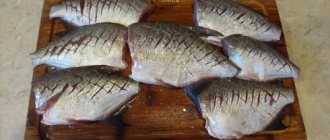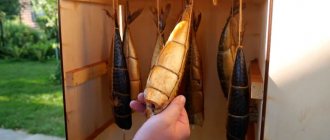- Shelf life: 6 months
- Shelf life: 6 months
- Shelf life in the refrigerator: 3 months
- Freezer life: 12 months
Storage conditions:
In a cool, dry place at a temperature not exceeding +8 ° C and a relative humidity of not more than 70%
The name of this delicious fish comes from one of the subspecies of river fish - or rather carp, which is called ram. At the moment, ram refers to almost all dry or dried fish. In addition to ram, roach and roach are dried, but if you have experience and skills, you can also prepare bream, perch or large crucian carp.
In central Russia, this particular fish is considered the best addition to beer, and its lovers often argue about tastes - which is the most delicious, dried or dried. Preparing dried fish can take more than one week, depending on the recipe chosen and the size of the fish.
Storage conditions
Long-term storage of dried fish is possible if certain conditions are met:
- maintaining the required temperature;
- insulation from sunlight;
- good air movement in storage areas;
- moderate humidity (60 – 70%).
The products are sent for storage immediately after drying. It should be understood that if dried carcasses have been in unsuitable conditions for some time, they will not be stored for long. Such foods should be consumed as quickly as possible.
The shelf life of dried fish varies from a week to 12 months. It all depends on the correct drying and further storage conditions.
Unpleasant odor, mold, worms are indicators of the decomposition process of the product. Such products should not be eaten.
How to tell if fish has gone bad
The most telling sign of spoiled fish is its unpleasant smell. It's so strong that you don't even have to sniff it.
Related signs of an expired product:
- sticky scales;
- the meat is dry and falls between the bones;
- the integrity of the carcass is compromised;
- the gills are dry and have a greenish tint;
- if you press on the abdomen, a dent remains.
High-quality dry fish will be intact and without damage, its scales will be smooth and shiny, and the product will have a characteristic fishy smell.
Dried and dried fish can be stored at home for up to 1 year! The main thing is to provide it with the right conditions and the required temperature. It should be taken into account that the shelf life of different types of fish differs, and the taste and structure of meat may change over time.
Indoor storage rules
It is best to store dried fish indoors in a suspended state. Carcasses tied with thick thread should be hung in a place with a low temperature:
- in the pantry,
- in the attic,
- on the loggia.
Direct sunlight exposure to dried carcasses should be limited.
In a dark, well-ventilated room with a temperature no higher than +8°C - +10°C, and humidity within 70 - 80%, the shelf life will be as long as possible.
- But before hanging the carcasses, it is recommended to wrap them in parchment paper. Large specimens are wrapped in paper one at a time, and small specimens are wrapped in several pieces at a time. The bundles are then hung up.
- It is important to store dried fish in rooms with little humidity.
- Bright sunlight poses a direct threat to this product, so keep it covered in as dark an area as possible.
- The shelf life of dried fish, if the rules are followed, is about 90 days.
Stages of drying roach
The process consists of several stages: salting, soaking and drying. There are two ways to pickle – dry and brine (wet).
Brine salting
The brine that is formed when salt dissolves in the liquid that oozes from the fish is called brine. It must be drained periodically during salting to prevent bacteria from multiplying in it.
With gutting
Usually large roaches weighing about 1 kg are gutted. Rinse the roach, do not remove the scales, remove the insides, remove the gills and rub with salt outside and inside. Take an enamel bowl, pour a layer of coarse salt on the bottom, place the roach in it, cover and press down with a weight. Thanks to the oppression, cavities do not form in the carcasses, where bacteria can grow and start rotting. Place in the refrigerator for three to four days. After some time, juice will begin to release from the fish.
No gutting
In this way, only small roaches can be salted - weighing from 250 to 500 grams and measuring no more than 30 cm in length. Gutting a small roach is recommended in the summer, when the fish eats greens, which give it a bitter taste.
Before salting, whole roach should be washed under running water, but you don’t have to wash it, just wipe it with a dry cloth.
For pickling, you need to prepare enamel dishes or a stainless steel container. Sprinkle salt on the bottom and place the roach in dense rows (belly to back, head to tail). Sprinkle each layer with salt to completely cover the fish. Larger specimens are placed downward, and smaller specimens are placed upward.
For salting you need to use only coarse salt.
Cover the roach with something flat and press it down with a weight (brick, jar of water, stone). Place the container with the fish in the refrigerator so that the flesh does not spoil, where the salt has not yet penetrated, and leave under pressure for three days. After three days, the roach is washed and left for 2 hours in cold water. The process of salting roach weighing no more than 500 grams takes two days.
You can determine readiness by the firm back, yellowish-red caviar and dark gray color of the meat.
Dry salting
This salting is more suitable for larger specimens and it lasts longer than brine - up to seven days.
The roach needs to be gutted and cuts made along the ridges. The fish must be sprinkled with salt, not forgetting the bellies, and placed in wooden boxes in a row. Cover the top with cellophane film and put it in a cold room.
With this method, the juice from the fish is also released, but flows through the cracks in the box
When the fish is salted, it must be rinsed under water and left to soak.
Soaking
After two days, the fish is washed under running water and then soaked for two hours.
It is believed that soaking lasts the same number of hours as the days the fish was salted.
The soaking time also depends on what kind of fish you like best: lightly salted or salted. In the first case, you need to keep the roach in the water longer, in the second, take it out earlier.
Drying (drying)
When the soaking is over, the water is drained and the fish is dried, spread out on paper for half an hour. Then the carcasses are hung out.
Hang the fish head up with a string through its eyes
Fish should be dried in a shaded place with a draft. The optimal air temperature for drying is about 20⁰C.
In summer, hanging carcasses need to be protected from flies. To do this, the fish are dipped in three percent vinegar and greased with vegetable oil or protected with gauze or a mosquito net. It is best to hang roaches in the evening, when there are no more flies. The carcasses will dry out overnight, and in the morning the flies will no longer harm them.
In winter, the kitchen in the apartment is suitable for drying roach. The fish is suspended over a gas stove.
Drying roach lasts from one week to four. After drying under natural conditions, the roach should ripen within three to four weeks. Small fish (up to 500 grams) can be eaten immediately after drying, skipping the ripening stage.
Dried roach should be stored in a fabric bag in a cool, ventilated room.
Cold storage
Keep this product in the middle part of the refrigerator, at a temperature no higher than +4°C. Before storing dried fish in the refrigerator, it should be well packed in wax paper. Here the storage approach is similar to the previous one. Large carcasses should be wrapped in paper individually, and small ones in several pieces. The shelf life of dried fish in the refrigerator is about 6 months.
What is the shelf life of dried fish?
At temperatures from 0 to +5°C it can be stored for up to 30 days, at temperatures from 0 to –5°C - up to 2 months. Dried fish can also be stored at sub-zero temperatures. The optimal storage temperature is from 0 to –8°C. Under these conditions, dried fish with a high fat content is stored for 2 months, with a low fat content - 4 months.
Interesting materials:
How to eat raw figs? How do they eat kiwi at the table? How to eat green asparagus? How to eat Ajaruli? How to eat artichokes raw? How to eat artichokes in oil? How to eat poultry dishes? How to eat a big hamburger? How to eat a burger according to etiquette? How to eat burgers with gloves?
In the freezer
Freezing allows dried fish to retain its taste for about 1 year.
The supplies are divided into parts, each carcass is wrapped in paper as tightly as possible, and then placed in bags. As much air as possible is expelled from the bags, after which they are sealed or sealed. Storing dried fish in the freezer in a bag without paper will damage the packaging due to sharp fins. After this, the fish will begin to lose moisture, freeze and acquire a bitter taste.
Defrosting should occur at room temperature, without the use of a microwave or hot air. When the carcasses are thawed, they are hung in places with good ventilation and dried for several hours.
Store for a long time
A large amount of dried fish in boxes, paper, and containers will not last long. Canning and freezing will keep a lot of dried fish throughout the year. I offer two proven methods:
| Photo | Instructions |
| Method 1. Freezing The easiest and most reliable way is freezing. The product will not lose its taste and beneficial qualities throughout the year. Remember that repeated freezing is unacceptable. To properly preserve fish:
Good briquettes are obtained when using polyethylene sealing | |
| Method 2. Canning In a jar with a tightly closed lid, all types of dried products, including ram, roach, and bream, can be stored for 6-8 months. The preservation process is suitable for small and medium-sized carcasses and consists of several stages:
|
The shelf life of frozen roach is reduced if the temperature is below -8 °C. Rolled jars should be placed in a cool room where there is no sun.
In a glass jar
Three-liter jars need to be thoroughly washed and sterilized. When they dry, fish are placed in them. Airless storage involves removing oxygen from the can.
- When the carcasses are tightly packed into the jar, a candle is placed there and set on fire.
- Then the jar is sealed with a lid.
- After there is no oxygen left in the jar (it will burn out), the fire will go out and a vacuum will form inside the jar, which will allow the fish to be stored for about 1 year.
- This happens because the harmful bacteria that cause rotting are unable to exist without oxygen.
Useful tips
The humidity required for storing dried fish should be moderate. It is important to adhere to this rule, because a very damp climate will cause mold to form. And due to storage in too dry a place, the carcasses will dry out and become unsuitable for consumption.
Depending on the condition of the fish at the time of purchase, its shelf life will depend. It is better not to store too dry specimens, but to consume them immediately.
Dried or dried fish in foil will also not be able to retain their quality for a long time due to the lack of air access. And in a plastic bag, condensation may occur, which contributes to the formation of mold. It is best to store carcasses wrapped in paper. The paper will prevent condensation and provide good ventilation.
Taran description, preparation, composition, benefits and harm
Ram (lat. Rutilus Heckelii) is a fish of the Cyprinidae family, belongs to the genus Roach. Lives in the seas (Black and Azov) and river mouths. Very popular among the peoples of Kuban, Don, and the Azov region.
Description of the ram
It differs from the common roach (R. rutilus) in its greater body height, smaller scales, fewer rays in the anal fin (the ram has 9-10), thicker teeth and blackish edges of paired fins. In addition, in the ram the internal cavity is covered with a black film, while in the common roach it is colorless.
READ ALSO: Planting parsley before winter. Parsley planting time
Taran is a medium-sized fish. The length of adult individuals ranges from 25 to 35 cm with a body weight of up to 1.8 kg.
Just half a century ago, the Sea of Azov and the rivers flowing into it were inhabited by a colossal number of rams, which were the object of fishing on an industrial scale. In recent decades, there has been a strong decline in the number of this fish, and it is rarely caught by fishermen. There is no longer any talk about commercial preparations. Apparently, the reason for this deplorable state of affairs is the poaching of rams at one time, although there are other versions: unfavorable natural circumstances for several years in a row (heavy floods, climate warming), deterioration of the ecological situation had a sharply negative impact on the reproduction of rams.
Ram lifestyle
Taran prefers to stay in slightly salty areas of the seas. It enters rivers mainly during spawning to lay eggs, and also sometimes in the fall for wintering, although most of the rams winter in the sea. Spawning occurs in the spring, although its progress can begin as early as mid-winter. It does not rise high in rivers. It spawns at the end of March - beginning of April in the grass and reeds. After spawning it returns back to the sea.
Otherwise, the habits of the ram are almost the same as those of the roach.
Taran in cooking
In the modern market, ram is usually found in dried form. However, if you managed to get fresh ram, then there is room for the culinary imagination to run wild. Taran is good fried. It has quite fatty meat, so it makes quite rich fish soup.
Calorie content, kcal - 235;
Proteins, g - 46.4;
Fats, g - 2.75;
Carbohydrates, g - 2.75.
Useful properties of ram
Taran is rich in protein, balanced in amino acid composition. It contains all nonessential and essential amino acids. The fat content, and hence the calorie content, of this fish is low, so it can be included in dietary dishes without restrictions. Naturally, only fresh fish prepared by boiling, frying, baking, or stewing can be considered healthy.
There are a lot of mineral elements in ram (zinc, sulfur, chlorine, fluorine, molybdenum, etc.).
Dangerous properties of ram
Taran has no special contraindications.
However, it should be borne in mind that dried ram can contain a lot of salt, so consuming it in large quantities can lead to edema. Dried ram is contraindicated for hypertension, diseases of the gastrointestinal tract and pancreas.
There are a lot of small bones in the ram, which is important to consider if you decide to give this fish to your child
Storing the battering ram
- After drying at home, it is advisable to store the ram in packaged form. Low air humidity leads to loss of mass, and high humidity leads to mold.
- Storing taranka in the fresh air can result in oxidation of the fat it contains, which will significantly spoil its taste.
Long-term storage of the ram is best at +3°C -+8°C and humidity 70 – 80%. If it is packaged in a special way, it will last for about 12 months.
Dried fish is normally stored at a temperature of +4°C. The temperature suitable for storage is usually kept in the refrigerator, in the area of its central part. Moreover, if you grease the carcasses with olive oil and keep them in a jar, they will last even longer. But you can simply wrap the battering ram with parchment, and then with cling film.
In order to store dried fish at home in accordance with all the rules, you should prepare the container in advance and create the necessary conditions.
It is important to maintain a certain temperature in storage areas and ensure that it does not exceed +8°C and the humidity level is 80%. Then you can count on the fact that the supplies will last as long as possible, and at any time there will be a wonderful snack in the house.
Product selection rules
Not all consumers are familiar with the production technology of this delicious and aromatic delicacy, so not everyone will be able to distinguish a quality product from a spoiled one.
The main signs of low-quality fish products include:
- The presence of a grayish-white coating on the scales. Sellers will mislead you by claiming that this is leaking salt. But this is not true at all - the fish is simply covered with mold.
- The first prohibition against purchasing is the presence of even a slight musty smell.
- You should not buy fish that are too dry (ram, bream) - after a while it will completely harden and it will simply be impossible to eat it. Although such a product has its fans.
- When buying fish that is too wet, you risk getting poisoned - it contains microbes harmful to the human body.
- If your fish smells like iodine, don't worry - this is a natural process of fish oil oxidation.
- A yellowish and slightly soft belly indicates a slight and acceptable deterioration in product quality.











